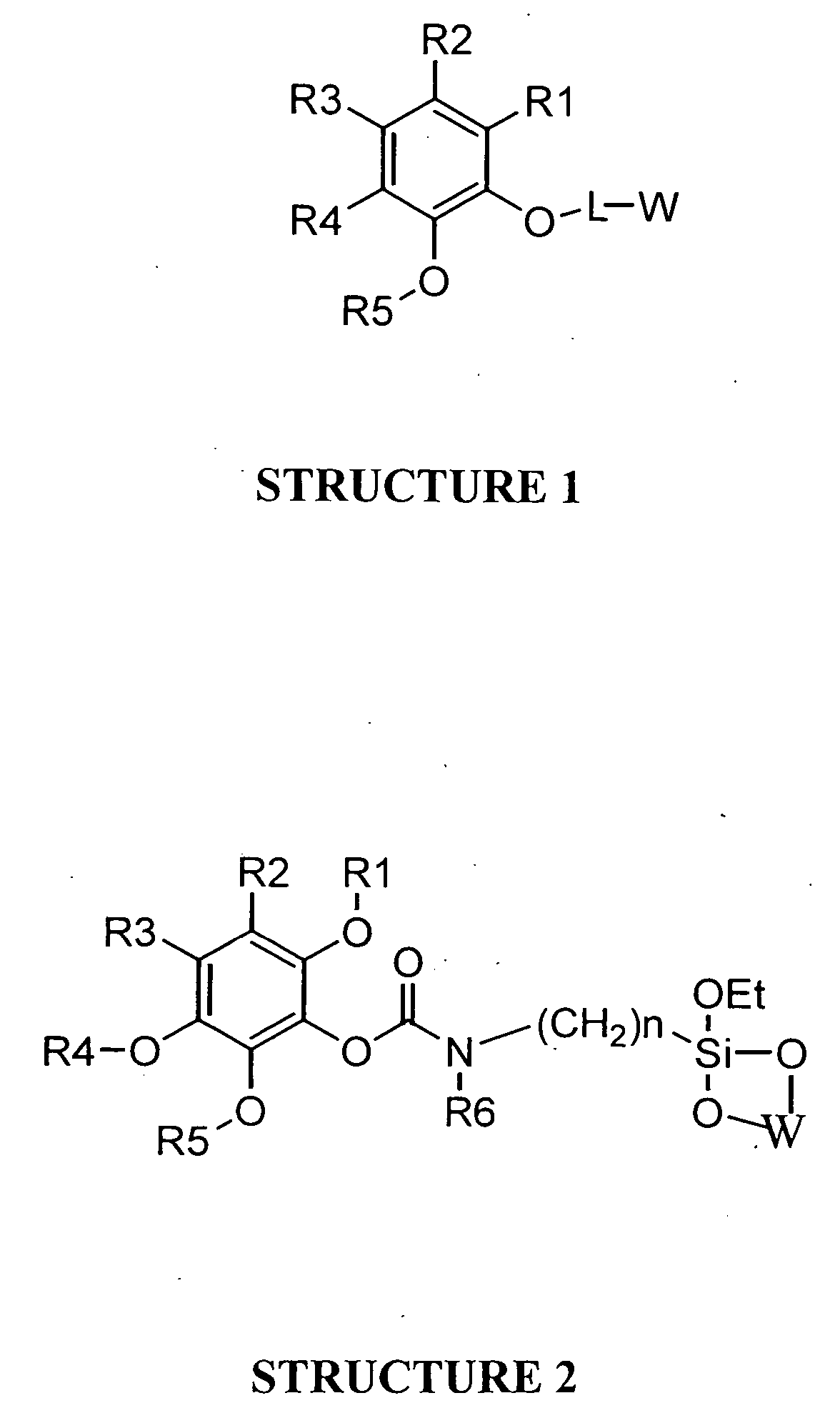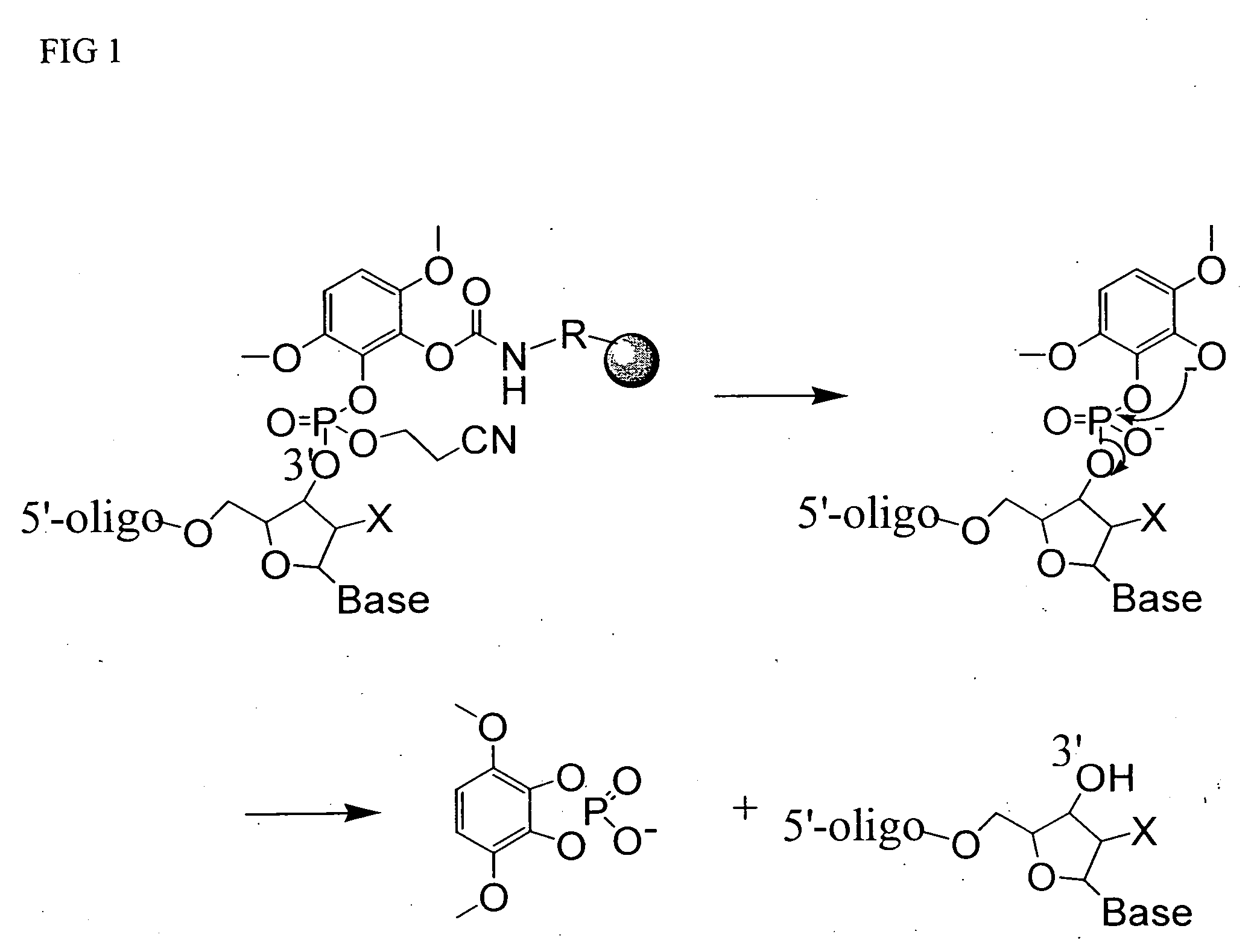Universal support for nucleic acid synthesis
a technology of nucleic acid and support, applied in the direction of peptide/protein ingredients, immunoglobulins, peptides, etc., can solve the problems of time-consuming, cumbersome, htp synthesis of nucleic acids,
- Summary
- Abstract
- Description
- Claims
- Application Information
AI Technical Summary
Benefits of technology
Problems solved by technology
Method used
Image
Examples
example 1
[0036] Dimethoxycatechol 1 was prepared in four steps from 2,5-dimethoxybenzaldehyde according to the literature. AminopropylCPG 3 was prepared by reacting CPG (75 / 200, 1000 angstroms pore size) with aminopropyltriethoxysilane in dichloromethane.
[0037] In a 200 mL round bottomed flask under argon, dimethoxycatechol 1 (305 mg, 1.8 mmol) was dissolved in dried THF (20 mL). Carbonyldiimidazole (1.02 equiv) was added at once. The reaction mixture was stirred for 30 min at room temperature, diluted with dichloromethane (20 mL) and added under argon to a suspension of aminopropylCPC 3 (10 g, 30 μmol / g) in dichloromethane. The flask was shaken at room temperature overnight. Additional carbonate 2 is added if a ninhydrin test detecting free amino groups is positive. Trimethylsilylimidazole (0.7 mL) is added and the flask is shaked for another two hours. Methanol (10 mL) is added and the flask is shaked for another 10 min. Dimethoxycatechol-CPG 4 is filtered, washed with methanol (2×) and d...
example 2
Deprotection with Ammonium Hydroxide
[0038] A support bound 25-mer DMT-on oligonucleotide was synthesized using universal solid support 4 (200 nmol, 10 mg), phosphoramidite chemistry and conventional protective groups by standard techniques known to those skilled in the art. To the 25-mer bound CPG in a 2 mL vial was added 1 mL of 30% ammonium hydroxide. The vial was sealed and heated at 80° C. for 60 mn. The supernatant solution was separated from the CPG support, which was washed with concentrated aq. ammonium hydroxide and discarded. The combined ammonium hydroxyde solutions were combined and analyzed by HPLC. The fully deprotected DMT-on 25-mer oligonucleotide was found to be identical to samples prepared from conventional commercial supports. HPLC analyses were carried out using a OPH® RP-L21 column (Organicphase Inc., 3.0×75 mm, particle size 5 μm). Sample volume was 10 μL using a flow rate of 0.75 mL / min. The column was equilibrated in buffer A (0.1M TEAA, pH 7.0) and eluted ...
PUM
| Property | Measurement | Unit |
|---|---|---|
| Acidity | aaaaa | aaaaa |
Abstract
Description
Claims
Application Information
 Login to View More
Login to View More - R&D
- Intellectual Property
- Life Sciences
- Materials
- Tech Scout
- Unparalleled Data Quality
- Higher Quality Content
- 60% Fewer Hallucinations
Browse by: Latest US Patents, China's latest patents, Technical Efficacy Thesaurus, Application Domain, Technology Topic, Popular Technical Reports.
© 2025 PatSnap. All rights reserved.Legal|Privacy policy|Modern Slavery Act Transparency Statement|Sitemap|About US| Contact US: help@patsnap.com



